
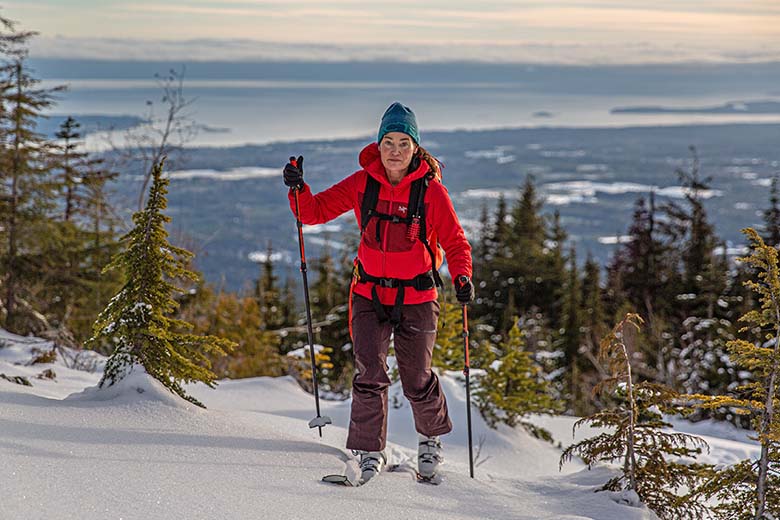
Price: $400
Weight: 1 lb. (women’s XS)
Insulation: Coreloft Continuous (100g & 60g)
What we like: Excellent balance of warmth and breathability for exerting in the cold.
What we don’t: Relatively heavy and bulky; not great for static activities or working hard in mild temperatures.
See the Women's Proton Heavyweight Hoody See the Men's Proton Heavyweight Hoody
Arc’teryx’s Proton line falls under a growing category of active insulators, which are purpose-built for keeping you comfortable during exertion. The most insulated of the bunch, the Proton Heavyweight Hoody is an impressively warm and breathable synthetic that works well for heart-pumping activities like backcountry skiing. I recently put the women’s version to the test on frigid adventures throughout British Columbia and came away impressed by the jacket’s ability to keep me cozy and sweat-free while working hard in cold weather. It’s far from the lightest or most versatile design but balances its priorities extremely well. Below I break down the Proton Heavyweight’s all-around performance. To see how it stacks up in the market, check out our articles on the best synthetic jackets and best women’s synthetic jackets.
As its name suggests, the Arc’teryx Proton Heavyweight Hoody is well insulated for cold temperatures. Specifically, the jacket is packed with 100-gram (g) Coreloft Continuous fill throughout most of the body, while the arms and hood use a lighter 60g variety. In practice, the jacket has kept me perfectly cozy while ski touring in temperatures down to around 5 degrees Fahrenheit, as well as on snowy hikes that dipped below freezing. In both cases, I layered minimally underneath and frequently alternated between stopping and going, which can often lead to clamminess and a chill creeping in. But the Proton handled it all with aplomb, keeping me comfortable and sweat-free despite the conflicting demands.
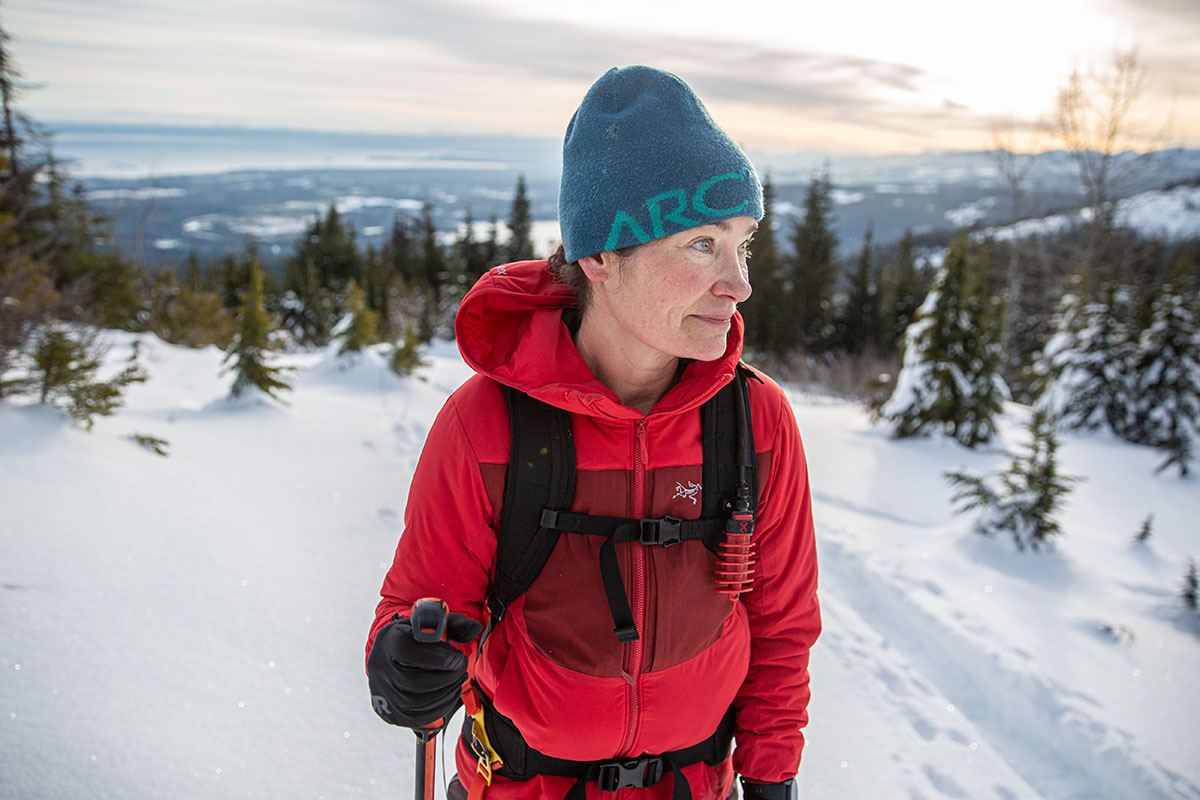
All that said, it’s important to note that the Proton Heavyweight Hoody is designed to keep you comfortable during exertion, which translates to limited warmth when you stop moving. For more sedentary activities like belaying or hanging around camp, I wouldn’t reach for the Proton unless temperatures were well above freezing. For these uses, a less breathable synthetic like Arc’teryx’s own Atom Heavyweight Hoody (which is insulated with a mix of 60, 80, and 120g Coreloft) or a down jacket like Rab’s Neutrino Pro (which is packed with 7.5 oz. of 800-fill-power down) would be a much better match. But as an active insulator, the Proton Heavyweight accomplishes its job of effectively balancing warmth and breathability.
While the Proton Heavyweight Hoody is no substitute for a fully waterproof shell in rowdy weather, it does an admirable job fending off moderate precipitation and wind. The thick outer shell helps (more on this in “Build Quality and Durability” below), as does the durable water-repellent (DWR) finish coating the exterior. Even on a hike that saw sleet and heavy snow, droplets beaded up and rolled right off the shell, and I was able to quickly brush off excess moisture that accumulated. Wind protection has been similarly impressive, with the hem and hood drawcords providing an added layer of defense for sealing out cold drafts. Arc’teryx also included an insulated flap behind the main zipper, which only adds to the impervious feel. I have needed to add a rain shell in downpours, but overall, the Proton Heavyweight strikes me as a perfectly capable standalone piece in most conditions.
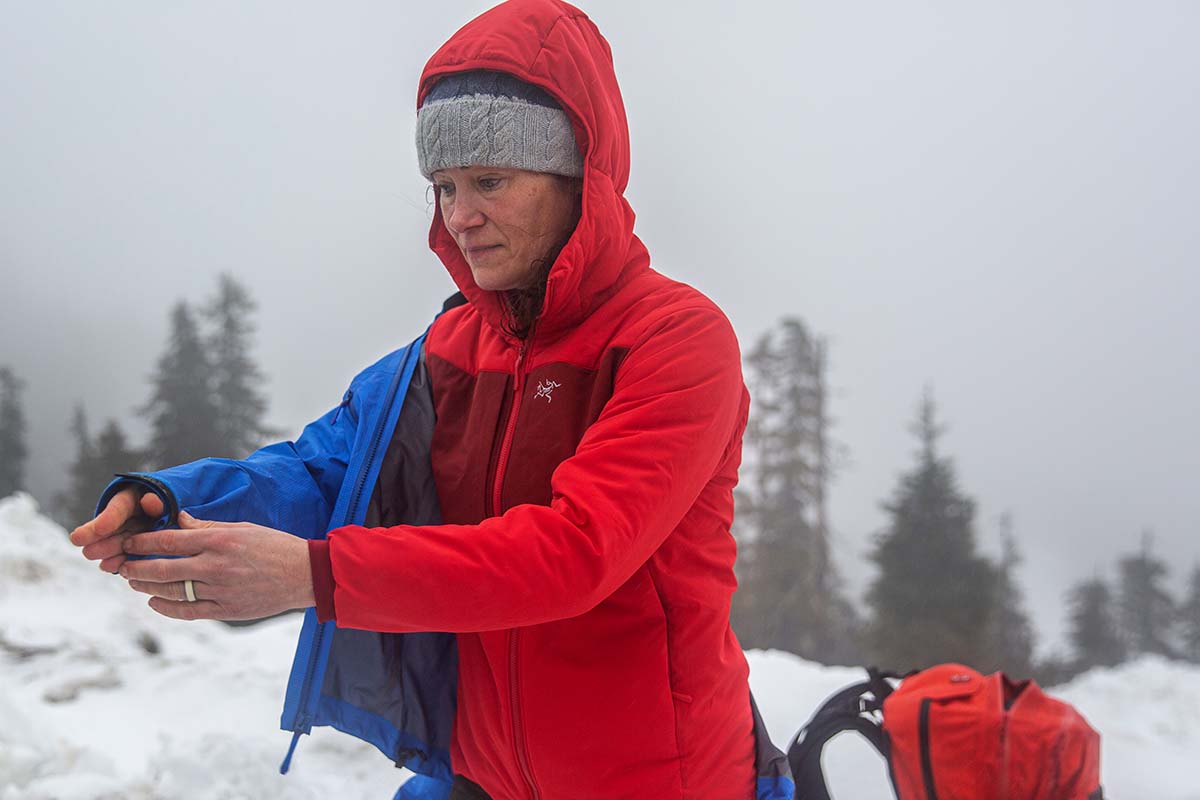
Designed as an active insulator, it came as little surprise that the Proton Heavyweight Hoody is an excellent breather. Even during heavy exertion, I haven’t grown sweaty wearing the jacket—an especially important trait when backcountry skiing, as there’s a lot of stop-and-go during transitions and when taking photos. I’ve even been able to stay comfortable while skiing down, which speaks volumes about the jacket’s warmth and wind resistance. It’s true that temperatures have been decidedly cold in testing, but I’ve nevertheless been impressed by the Proton’s ability to keep me both cozy and sweat-free.
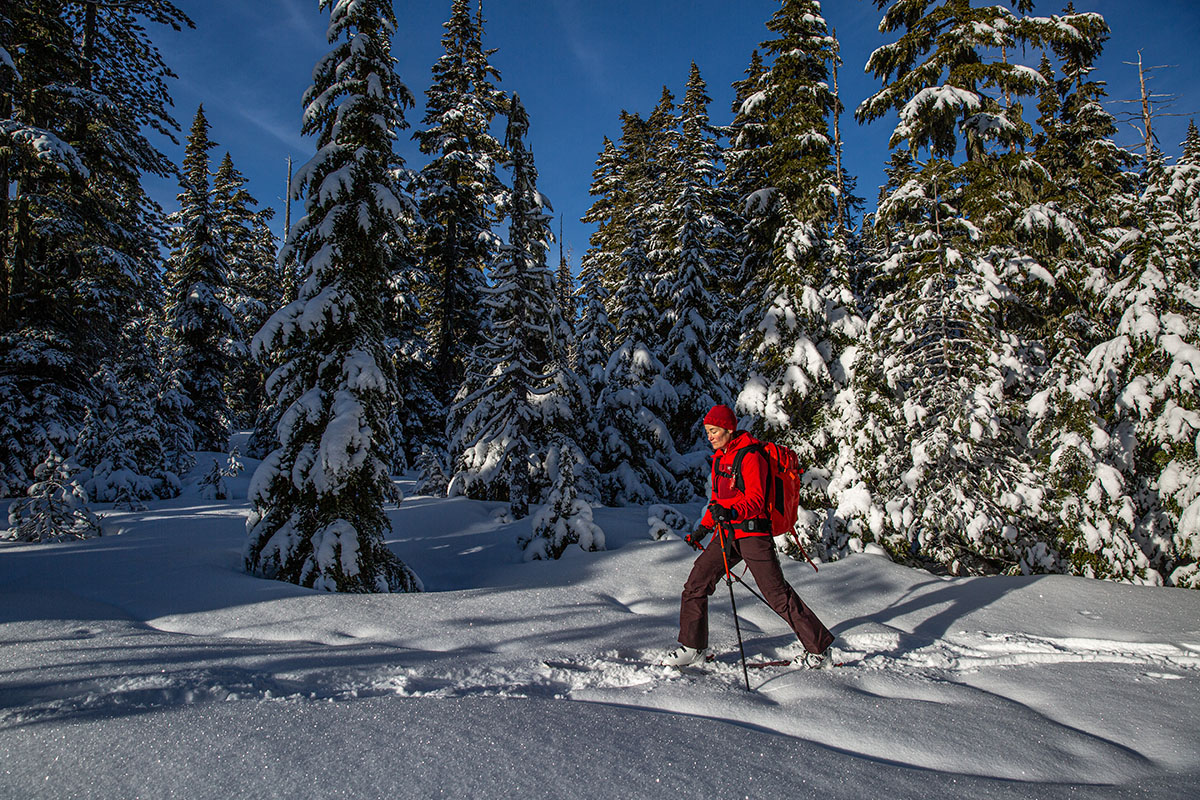
At 1 pound even for my women’s size extra small (listed weight is slightly higher at 1 lb. 0.9 oz.), the Arc’teryx Proton Heavyweight Hoody isn’t the best option for weight-conscious missions when every ounce counts. For that, we turn to down jackets like Patagonia’s Fitz Roy Down Hoody, which provides winter-ready warmth in a lighter (14.8 oz.) and more compressible package. That said, synthetics like the Proton have the clear edge in weather protection, as they will continue to insulate when wet (for more on the differences, check out our article on Down vs. Synthetic Insulation). If the latter is more important to you, the Proton Heavyweight stacks up decently well in the market, splitting the difference between competitors like Arc’teryx’s own Atom Heavyweight Hoody (13.9 oz.) and Rab’s Xenair Alpine Insulated Jacket (1 lb. 1.2 oz.).
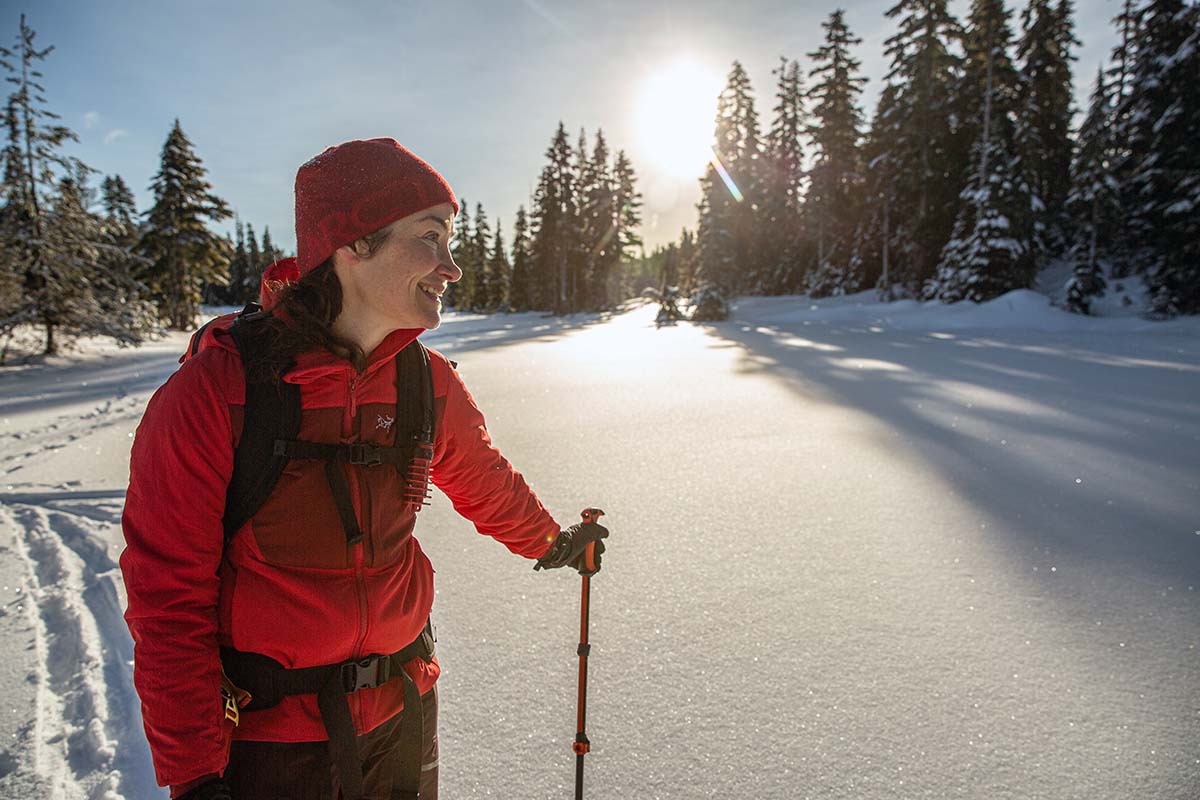
Weight almost always lines up closely with packability, and the Proton Heavyweight Hoody is predictably large. When compressed, my women’s extra small packs down to roughly the size of an American football. There’s no dedicated stuff sack or pocket, but it’s easy to stuff the jacket into its hood and use the drawcord to compress the package down— or simply shove it around other gear in my pack.
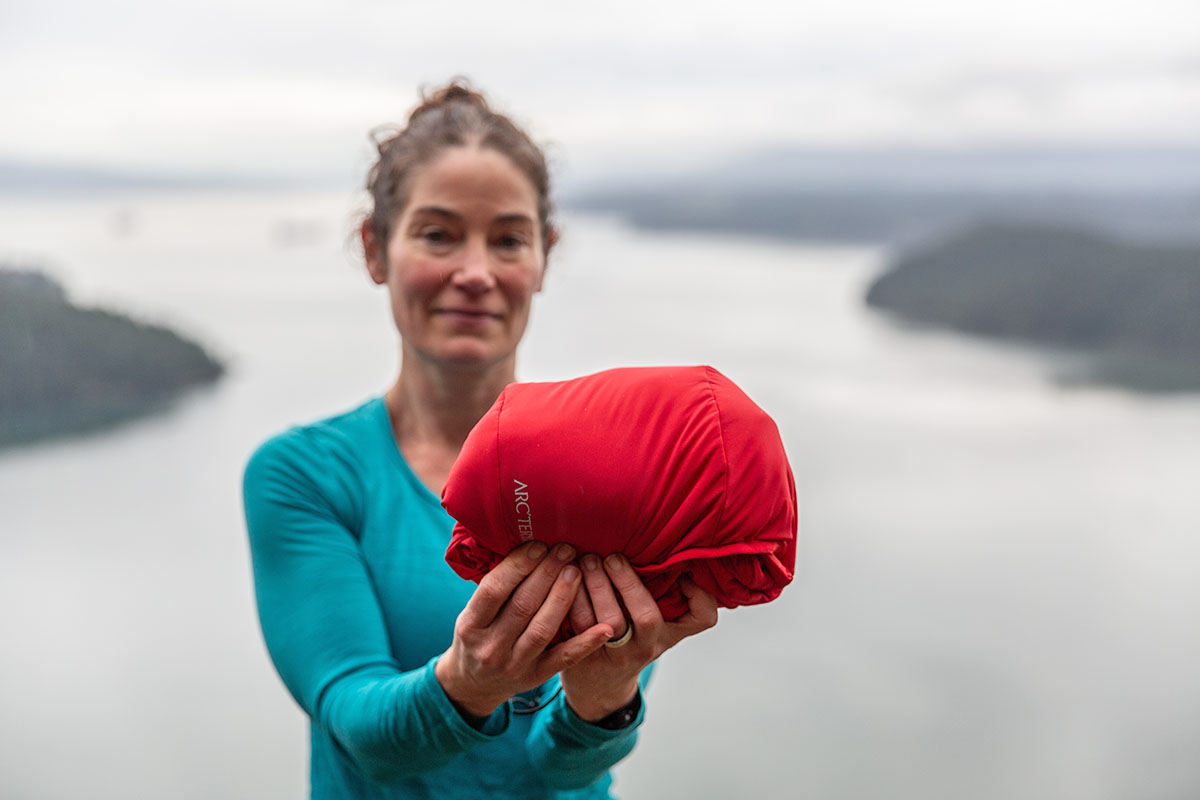
I’ve had positive experiences with other members of the Proton family in terms of comfort, and the Proton Heavyweight Hoody carries the torch. For starters, the liner is soft against the skin (even with just a T-shirt underneath), wicks moisture well, and slides easily over baselayers. The hand pockets also feature a soft, fleece-like lining, which is a boon against cold and dry fingers. Finally, as expected from an active insulation piece, the Proton Heavyweight offers unrestricted freedom of movement with a relatively stretchy shell and articulated patterning for added mobility. In fact, the jacket has gone largely unnoticed while skinning, transitioning, and skiing, which is not an easy feat.
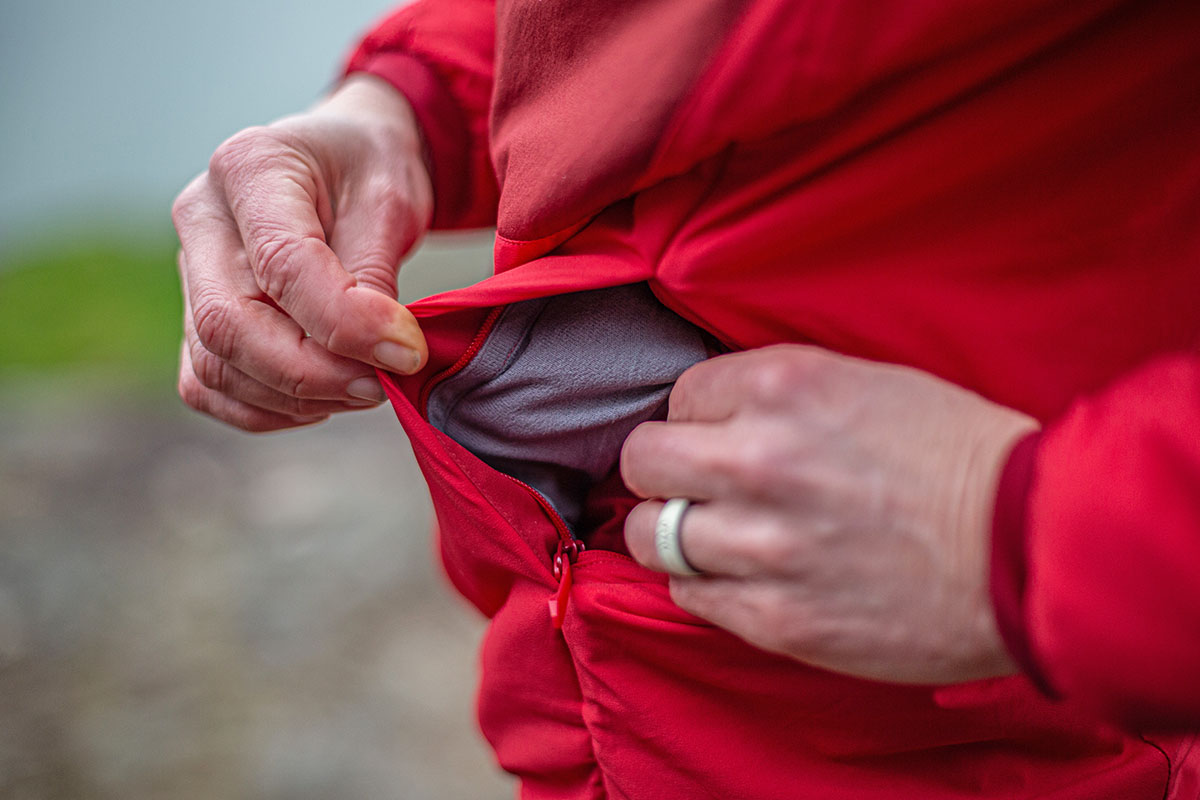
I’ve had largely positive experiences with Arc’teryx jackets over the years, and the Proton Heavyweight Hoody is another well-built and hardwearing piece. For starters, the shell fabric is relatively thick at 50 denier (D) and has handily fended off snags and abrasion throughout testing. Importantly, the Coreloft fill has also retained its loft despite frequent and extensive use, often with a ski backpack compressing the insulation at the shoulders. All of the smaller components are holding up equally well, from the smooth-operating zippers and drawcords to the elasticized cuffs. Given my positive experiences thus far, I expect the Proton Heavyweight Hoody to last several more seasons without issue.
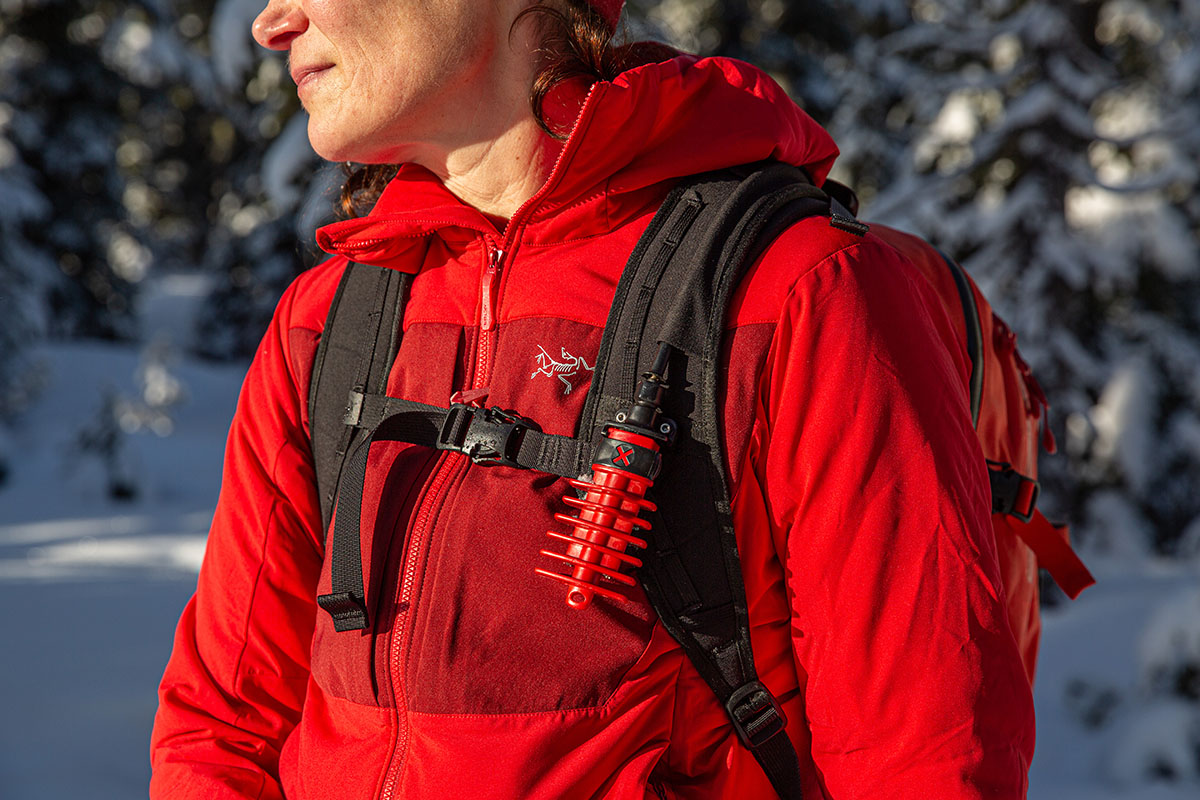
The Proton Heavyweight features Arc’teryx’s signature StormHood, which is my favorite design on the market. For adjustability, you get a single drawcord at the back, which is easy to tighten with one hand and does a nice job cinching things down (although it does require two hands to loosen). True to the jacket’s technical intentions, the hood is also climbing helmet-compatible. There is some restriction when stretched over a bulkier ski helmet, but it hasn’t been a major issue for me since I prefer to don my shell’s hood or no hood at all when descending. Finally, it’s worth noting that the hood is insulated with 60g Coreloft Continuous compared to 100g throughout most of the body, but I haven’t noticed any discernible difference in warmth—and the reduction in bulk is a welcome benefit.

The Proton Heavyweight Hoody comes well equipped in the storage department with six total pockets. Starting at the outside, you get two zippered hand pockets and two zippered chest pockets. The former boast a fleece-like lining for warming cold hands, while the latter are large enough to stash a smartphone or Garmin inReach. Inside, there are two large dump pockets that easily swallow an extra pair of gloves or a beanie. They’re also large enough to fit a pair of climbing skins, but it’s a bit of a tight squeeze (although I did size down, which leads me to believe going with my usual size would have resulted in plenty of room). All in all, it’s a very generous and functional layout that makes it easy to divvy up the essentials.
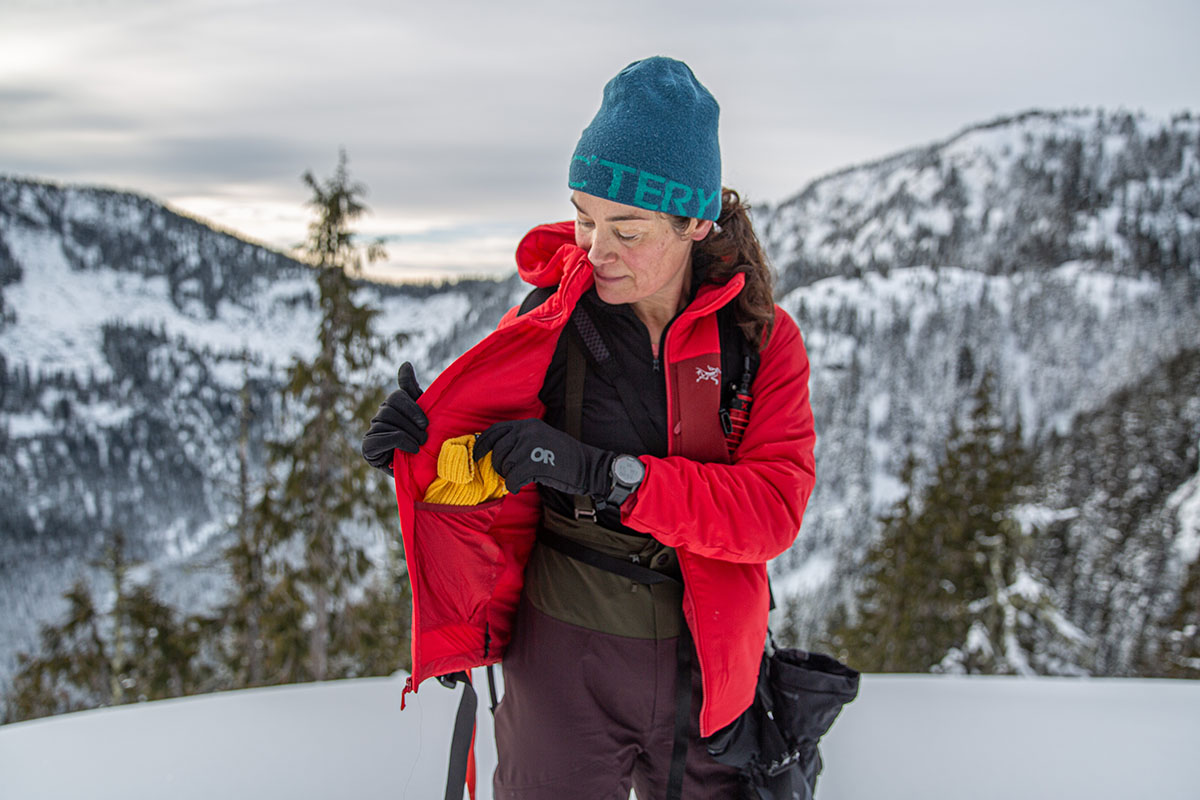
I’ve historically worn a size small in Arc’teryx jackets, but I’ve found that newer pieces—especially those dubbed a “regular” fit—tend to run a bit bigger. With this in mind, I opted to size down to a women’s extra small and was happy with my choice. With a couple baselayers underneath, the jacket fit perfectly with a just-right amount of room for stashing necessities like my avalanche beacon, gloves, and a beanie in various pockets. Importantly, the arms were also a great length and stayed put when reaching overhead or digging myself out of a powder pit after a fall. I’d recommend those between sizes try the jacket on before buying, but given my experiences, sizing down seems like a safe bet.
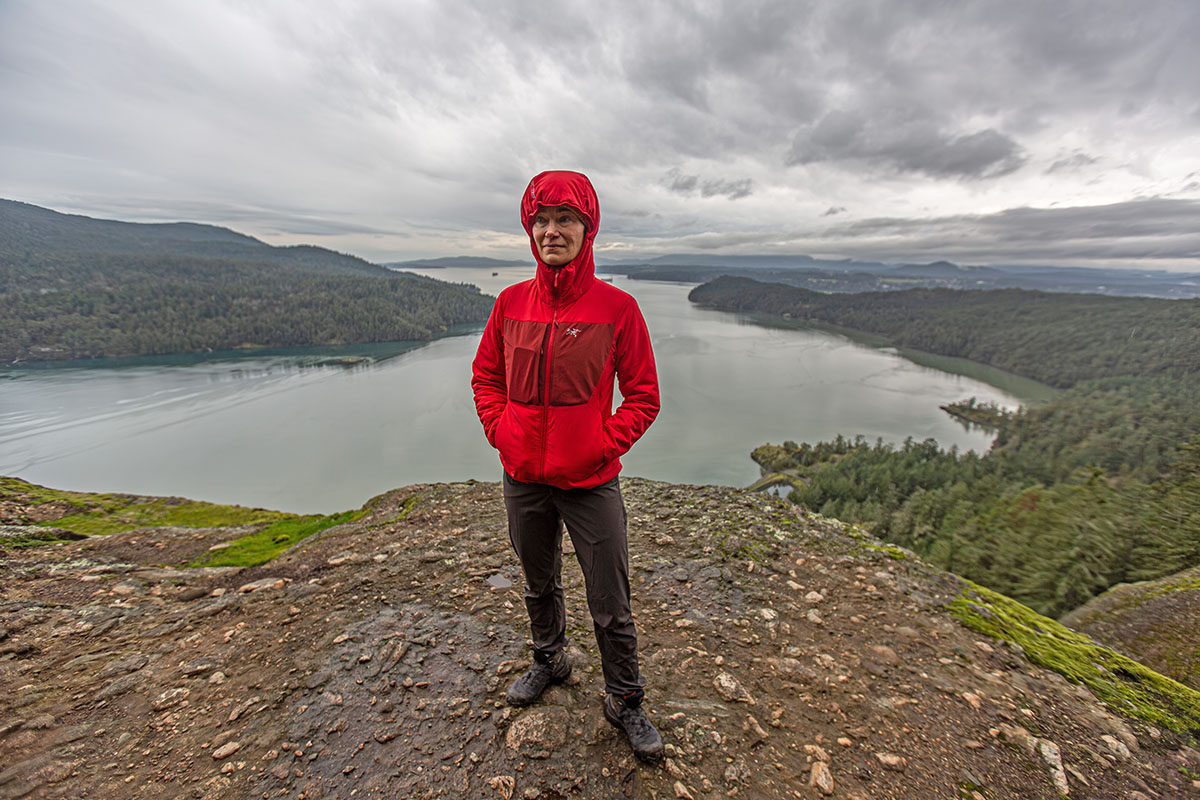
Like many leading outdoor brands, Arc’teryx has made notable inroads on the sustainability front in recent years. The latest Proton Heavyweight Hoody is a case in point: The jacket is made with raw materials that contain at least 30% recycled content and boasts a PFC-free DWR coating that forgoes the use of harmful per- and polyfluoroalkyl substances. We’d love to see a higher percentage of recycled materials in a future update, but overall, the Proton Heavyweight is a nice reflection of Arc’teryx’s ongoing sustainability efforts.
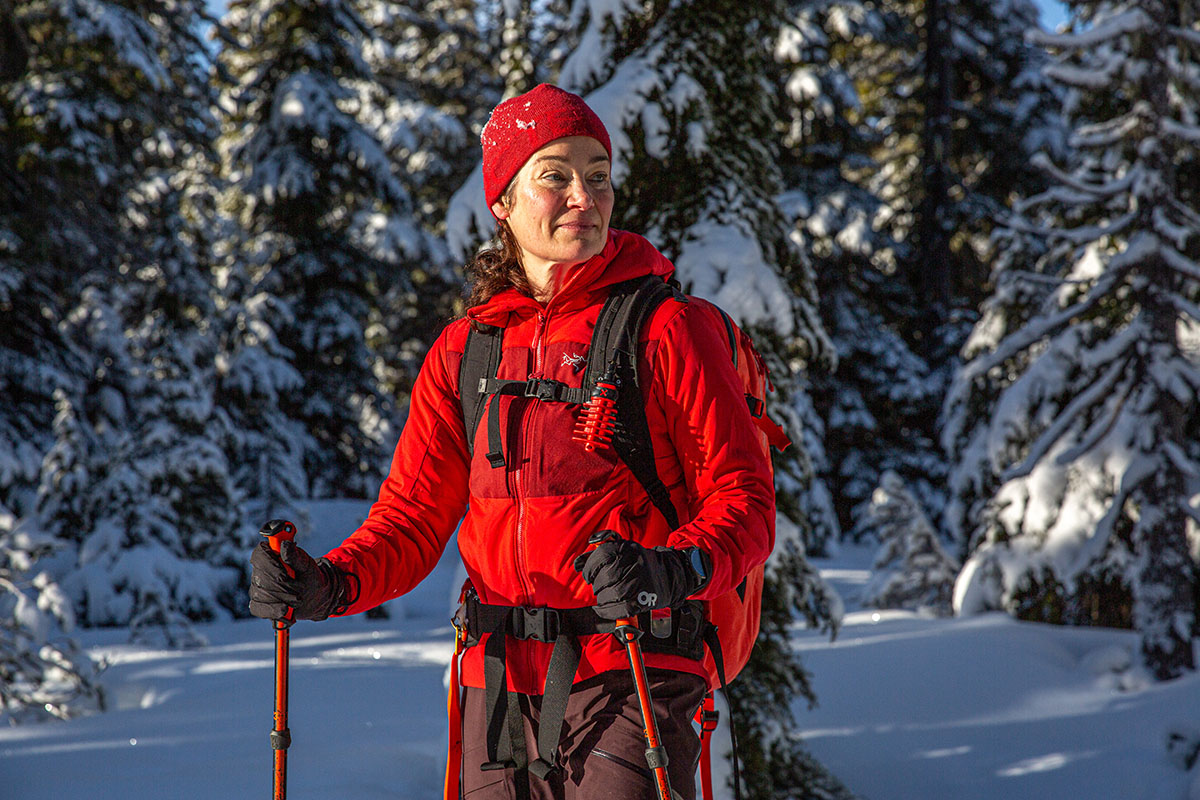
In addition to the women’s Proton Heavyweight tested here, Arc’teryx’s makes the jacket in a men’s version for the same price. Comparing the two, the men’s Proton Heavyweight Hoody is a few ounces heavier at 1 pound 3 ounces and comes in different colorways but retains an otherwise identical construction and feature set. Like the women’s jacket, the men’s is insulated with a mix of 60g and 100g Coreloft Continuous, boasts six total pockets, and features Arc’teryx’s well-executed StormHood. We haven’t had a chance to test the men’s version yet, but given its similarities, we expect overall performance to be largely similar.
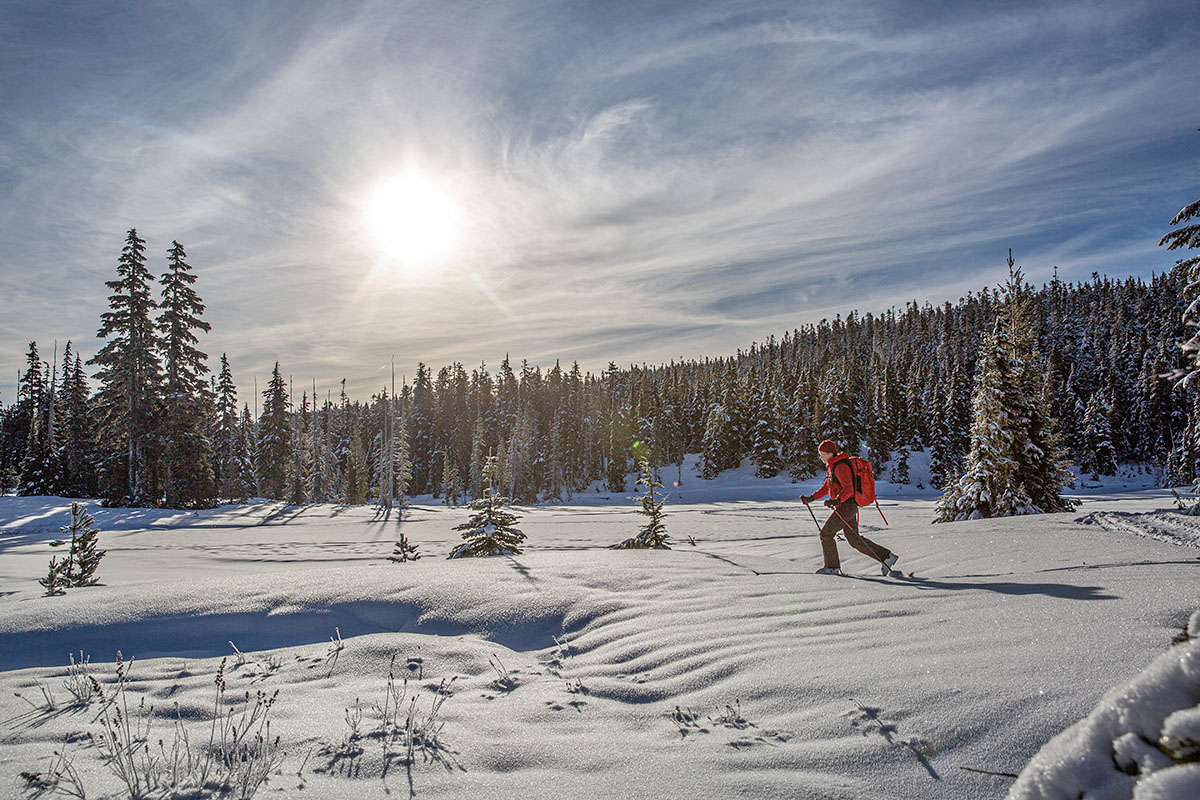
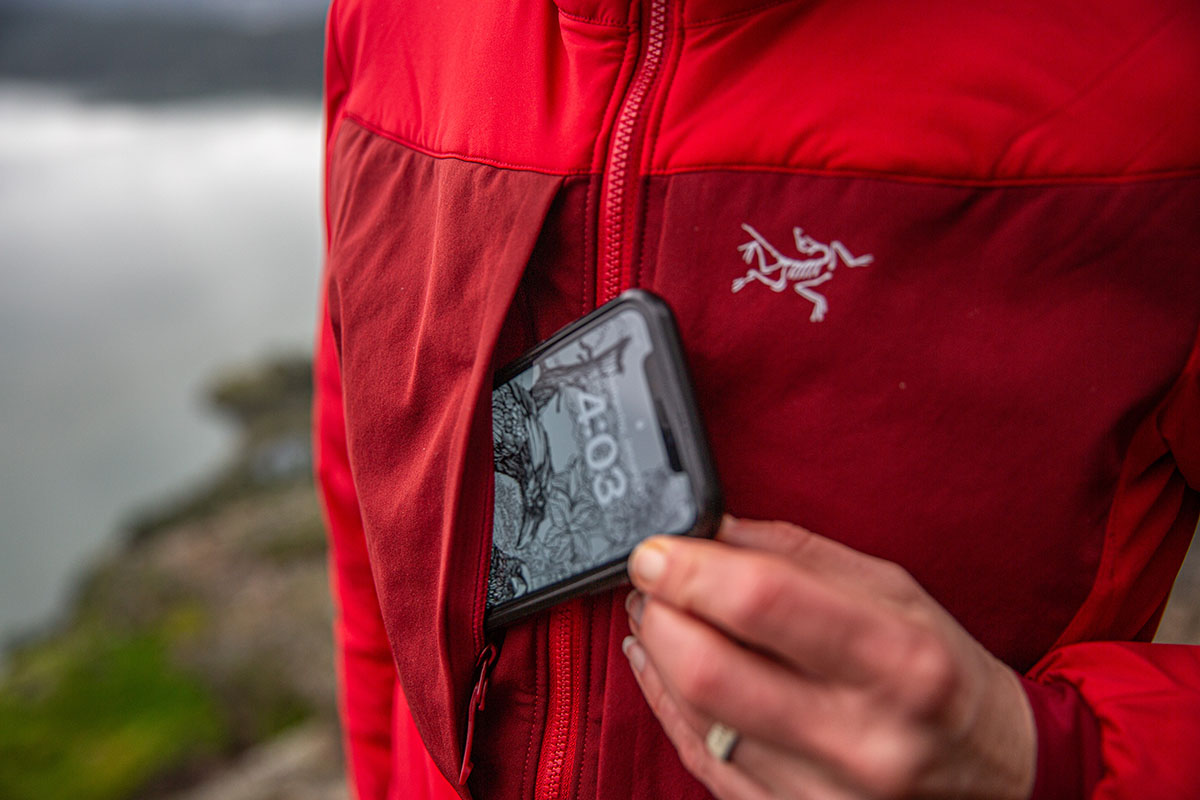
| Jacket | Price | Weight | Insulation | Fabric | Packable |
|---|---|---|---|---|---|
| Arc’teryx Proton Heavyweight | $400 | 1 lb. 0.9 oz. | Coreloft Continuous (100g & 60g) | 50D | No |
| Arc'teryx Atom Heavyweight | $350 | 13.9 oz. | Coreloft (120g, 80g, & 60g) | 30D | No |
| Arc'teryx Proton Hoody | $350 | 12.7 oz. | PrimaLoft Gold Active Vent (80g) | 20D | No |
| Rab Xenair Alpine Insulated | $260 | 1 lb. 1.2 oz. | Primaloft Gold Active+ (133g) | 20D | No |
| Patagonia Fitz Roy Hoody | $399 | 14.8 oz. | 800-fill-power down | 20D | Yes |
The Proton Heavyweight Hoody is great for working hard in cold weather, but warmth is limited when you’re standing still. Enter Arc’teryx’s own Atom Heavyweight Hoody, which is less breathable than the Proton but the better match for standalone use when you’re not working up a sweat. In testing, we found the Atom too hot for any substantial uphill climbs, even in sub-freezing temperatures, but it was a great match for collecting water, using a stove, and moving around camp. It’s also lighter than the Proton Heavyweight at 13.9 ounces and more packable, making it a much closer down jacket alternative (but with the added wet-weather assurance of synthetic fill). Added up, the two have very different priorities, and you’ll want to pinpoint your intended use(s) before deciding which one to buy (for more, check out our in-depth Atom Heavyweight Hoody review).
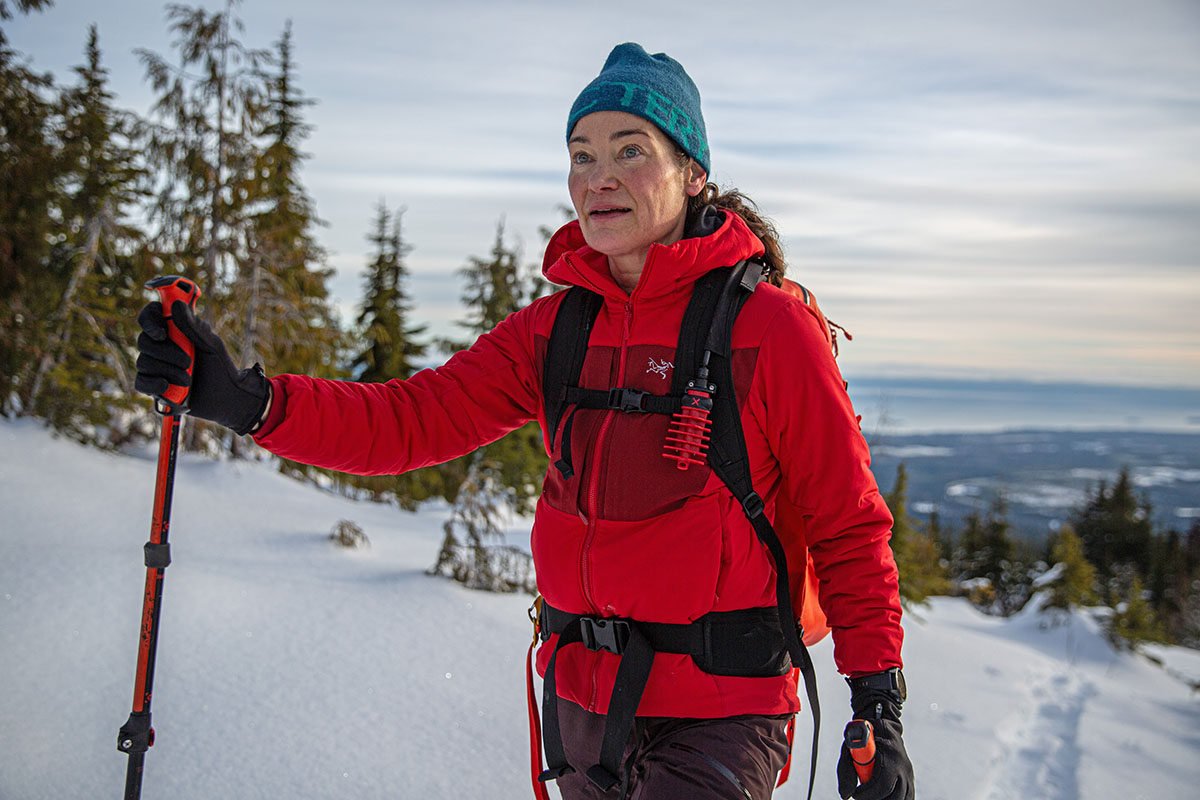
Alternatively, those who run warm or who only plan to get out in mild winter weather may want to consider saving with the standard Proton Hoody. For $50 less than the Heavyweight, the Proton Hoody is considerably lighter at 12.7 ounces, packs down much smaller, and has a trimmer “fitted” cut that makes it easier to layer underneath a rain shell. Other differences include a thinner (20D) shell fabric, three total pockets (compared to the Heavyweight’s six), and the use of 80g PrimaLoft Gold Active insulation rather than 100g Coreloft Continuous (with 60g in the arms and hood). In the end, we’d break it down as follows: The Proton Heavyweight is worth the added investment for those who regularly get out in frigid temperatures, but the standard Proton is the more versatile option and will get the job done in most shoulder-season and winter conditions (provided you’re moving, of course).
Moving away from Arc’teryx’s lineup, Rab’s Xenair Alpine Insulated Jacket shares the Proton’s intentions as a winter-ready active insulator. In this case, the Rab is packed with thicker, 133-gram PrimaLoft insulation and tacks on a weather-ready Pertex Quantum Air shell for added assurance when the skies open up. Other advantages include a two-way zipper that keeps the jacket out of the way when belaying, a stiffened brim on the hood for deflecting moisture, and water-resistant zippers to protect the pockets—all for a considerable $140 less than the Proton Heavyweight. That said, the Arc’teryx wins out in durability with a thicker shell fabric (50D vs. 20D for the Rab), weighs a little less, and breathes better when you’re working up a sweat. In the end, a final decision will largely come down to your priorities and objectives, but we consider the Proton to be the better active insulator, while the Rab is well suited for light exertion and more static activities like belaying.
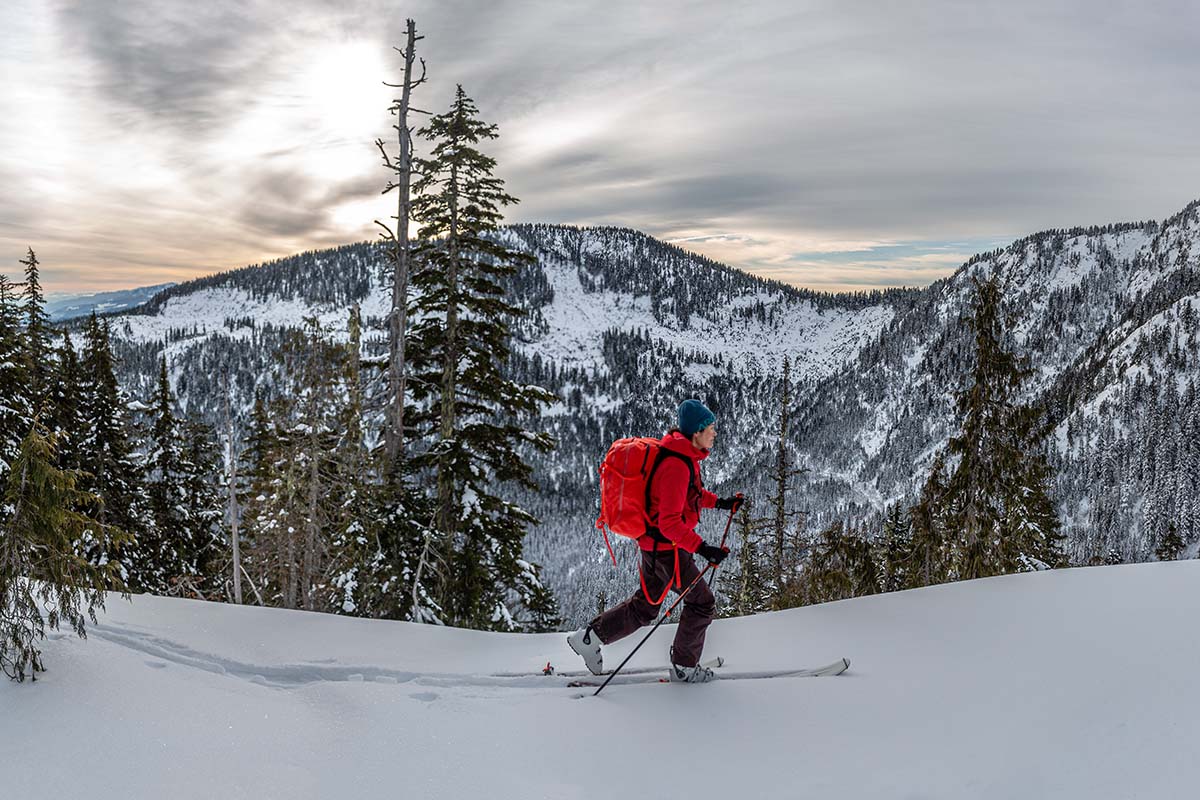
Last but not least, it’s worth comparing the Proton Heavyweight Hoody to a down jacket to showcase the benefits and drawbacks of both insulation types. For around the same price, Patagonia’s Fitz Roy Down Hoody is a legendary winter piece. Highlights include the use of lofty 800-fill down that results in much better compressibility, a lower weight of 14.8 ounces, and a similarly well-executed feature set that comprises an adjustable and helmet-compatible hood, an internal storm flap behind the main zipper, and a very functional pocket layout (five total compared to the Proton’s six). As we mentioned above, synthetics get the clear edge in wet-weather protection, although we appreciate that Patagonia equipped the Fitz Roy with a water-resistant Pertex Quantum shell that does a nice job fending off light moisture. The Proton Heavyweight also wins out in durability and wind resistance with a thicker, non-baffled shell, but the Fitz Roy is our preferred option when weight and packability take precedence.